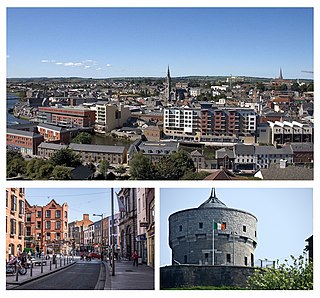
Drogheda is an industrial and port town in County Louth on the east coast of Ireland, 42 km (26 mi) north of Dublin city centre. It is located on the Dublin–Belfast corridor on the east coast of Ireland, mostly in County Louth but with the south fringes of the town in County Meath, 40 km (25 mi) north of Dublin city centre. Drogheda had a population of 44,135 inhabitants in 2022, making it the eleventh largest settlement by population in all of Ireland, and the largest town in the Republic of Ireland, by both population and area. It is the last bridging point on the River Boyne before it enters the Irish Sea. The UNESCO World Heritage Site of Newgrange is located 8 km (5.0 mi) west of the town.
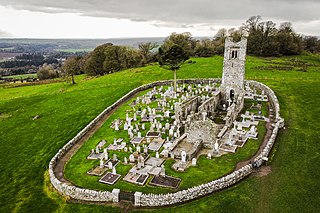
Slane is a village in County Meath, in Ireland. The village stands on a steep hillside on the left bank of the River Boyne at the intersection of the N2 and the N51. As of the 2022 census, Slane's population was 1,445. The village and surrounding area contains many historic sites dating back over 5,000 years. The village centre, as it is laid-out today, dates mainly from the 18th century. The village is in a townland and civil parish of the same name.
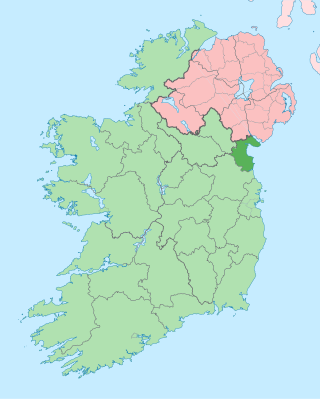
County Louth is a coastal county in the Eastern and Midland Region of Ireland, within the province of Leinster. Louth is bordered by the counties of Meath to the south, Monaghan to the west, Armagh to the north and Down to the north-east, across Carlingford Lough. It is the smallest county in Ireland by land area and the 17th most populous, with just over 139,100 residents as of 2022. The county is named after the village of Louth. Louth County Council is the local authority for the county.
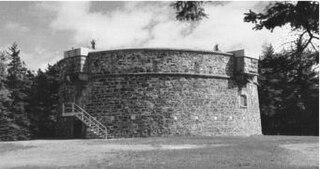
Martello towers, sometimes known simply as Martellos, are small defensive forts that were built across the British Empire during the 19th century, from the time of the French Revolutionary Wars onwards. Most were coastal forts.

Trim is a town in County Meath, Ireland. It is situated on the River Boyne and, as of the 2022 census, had a population of 9,563. The town is in a civil parish of the same name.

The siege of Drogheda took place from 3 to 11 September 1649, at the outset of the Cromwellian conquest of Ireland. The coastal town of Drogheda was held by a mixed garrison of Irish Catholics and Royalists under the command of Sir Arthur Aston, when it was besieged by English Commonwealth forces under Oliver Cromwell. After Aston rejected an invitation to surrender, the town was stormed and much of the garrison executed, along with an unknown but "significant number" of civilians. The aftermath of the siege is viewed as an atrocity which still impacts Cromwell's modern reputation.
Sir Arthur Aston was a soldier, most noted for his support for King Charles I in the English Civil War, and in folklore for the gruesome manner of his death in Ireland. He was from a prominent Roman Catholic family originating in Cheshire. He was killed during the Siege of Drogheda during the Cromwellian Conquest of Ireland.
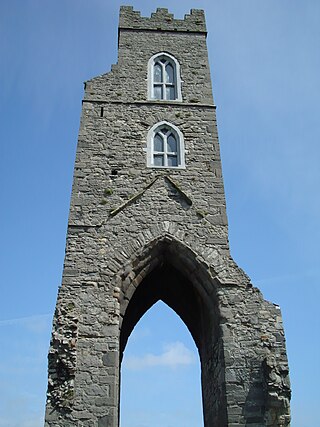
Magdalene Tower is a landmark located at the highest point of the northern part of Drogheda, County Louth, in Ireland. All that now remains of the once important Dominican Friary is the belfry tower. Lucas de Netterville, then Archbishop of Armagh, founded the monastery in about 1224.
Jersey is a heavily fortified island with coastal fortifications that date to the English Civil War, the Napoleonic Wars, and Nazi Germany's occupation of the Channel Islands. The fortifications include castles, forts, towers, Martello towers, artillery batteries, and seawalls. Not infrequently, fortifications from one period are built on the site of earlier fortifications, or very near them, geography having remained the same even when firepower increased.

Mornington is a coastal village on the estuary of the River Boyne in County Meath, Ireland approximately 5 km downriver from the centre of Drogheda. Together with the neighbouring villages of Laytown, Bettystown and Donacarney, it comprises the urban area of Laytown–Bettystown–Mornington–Donacarney with a combined population of 15,642 at the 2022 census.

The Pentagon Barracks, also known as the Old United States Barracks, is a complex of buildings located at the corner of State Capitol Drive and River Road in Baton Rouge, Louisiana, in the grounds of the state capitol. The site was used by the Spanish, French, British, Confederate States Army, and United States Army and was part of the short-lived Republic of West Florida. During its use as a military post the site has been visited by such notable figures as Zachary Taylor, Lafayette, Robert E. Lee, George Custer, Jefferson Davis, and Abraham Lincoln.
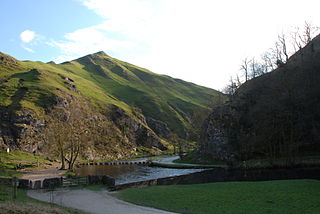
Dowdall is an Irish surname. The earliest forms of spelling were: Dowdell, Dowdale and Dowdle. Dowdall was first used as a surname in Yorkshire, certainly by the time of the Norman conquest of England.

Fort Hommet is a fortification on Vazon Bay headland in Castel, Guernsey. It is built on the site of fortifications that date back to 1680 and consists of a Martello tower from 1804, later additions during the Victorian Era, and bunkers and casemates that the Germans constructed during World War II.

St. Peter's Church of Ireland is an Anglican (Episcopalian) church located in Drogheda, Ireland, in the Diocese of Armagh. Designed in the Georgian style, St. Peter's starkly contrasts with the Neo-Gothic Roman Catholic church of the same name, located in the town centre.

Athlumney Castle is a tower house and fortified house and a National Monument in Navan, Ireland.

Dunmoe Castle is a castle and National Monument located near Navan, Ireland.
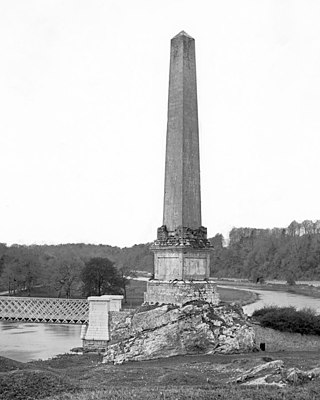
The Boyne Obelisk, also known as King William's Obelisk, was an obelisk located in Oldbridge, near Drogheda, County Louth, Ireland.
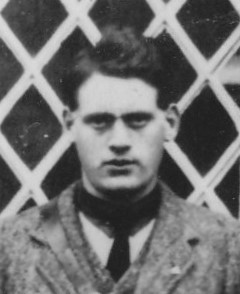
Christopher Patrick Burke was an Irish revolutionary, hunger striker and sportsman from the prominent Drogheda family, the Burkes of Duleek Street. At just 21, he was made officer in command of the Irish Republican Army (IRA) Arsenal in Bailieborough, County Cavan, on the recommendation of General Seán Mac Eoin. During the Irish Civil War, he underwent a hunger strike lasting twenty-three days.
29 Martello towers and battery installations were constructed or partially constructed in the Greater Dublin Area between 1803 and 1808. The towers were intended to act as a deterrent against a foreign invasion by Napoleon and his French Armies as well as being used as general lookout posts. In later years, towers were also used as coast guard stations, lookout stations to prevent smuggling and as other general purpose military installations by various British and Irish defence forces.


























